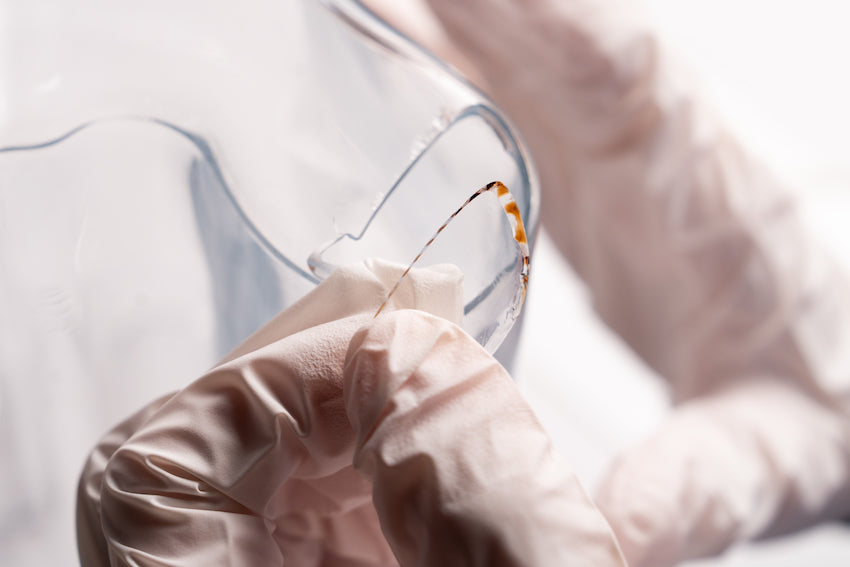Kintsugi has traditionally been used to restore broken porcelain and ceramics using urushi lacquer and gold powder.
Recently, however, many customers visit us to ask us repair not only expensive glass products but also glass products that they have a special attachment to and do not want to throw away.

▲ Baccarat Glass Kintsugi
We have been challenging glass kintsugi, which is not usually done by lacquer craftsmen, but now students in our kintsugi classes also want to try glass kintsugi by themselves! Therefore, we are now teaching this technique in our classes only.
Since regular urushi lacquer cannot adhere to glass, we uses and sells a special lacquer for glass.
Since we receive many questions about glass kintsugi and lacquer for glass, which are not available to the general public, we have written this article in the hope that it will help you.
Table of Contents
- Can I repair glass products with Tsugu Kit?
- Is the lacquer for glass food-safe?
- Do you have instructions for repairing glass?
- Differences Between Regular Urushi Lacquer and Lacquer for Glass
- Similarities Between Regular Urushi Lacquer and Lacquer for Glass
- Cautions Specific to Glass Kintsugi - Color
- Cautions Specific to Glass Kintsugi - Sanding
- Damage Types That Cannot Be Repaired
- Kintsugi on Jade
- Summary of Glass Kintsugi
Can I repair glass products with Tsugu Kit?

Unfortunately, tsugu kits (and the other kintsugi kits) cannot restore glass.
The reason is that urushi lacquer has weak adhesive strength to smooth surfaces such as glass.
If you want to repair glass, you will need additional materials, a different process, and advanced techniques.
Recently, urushi lacquer with enhanced adhesion to glass was developed, so you will need to purchase this at least. However, it is not like synthetic adhesives, which you just apply, stick and done! Also, it is not possible to repair all kinds of glass breakage with the special urushi lacquer for glass.
Is the lacquer for glass food-safe?

Yes, it is tested and proven as food-safe.
However, some of the lacquer for glass sold by other companies do not pass food safety laws (or have not been tested), so we recommend that you contact the manufacturer in advance if you are concerned.
Product page: Lacquer for glass
Do you have instructions for repairing glass?
Our lacquer for glass comes with an instruction manual, but it will not enable us to repair all types of broken glass.
Although it is possible to give a brief explanation to those who purchase the lacquer for glass in our studio, glass kintsugi requires a high level of skill, and it is not something that can be done with just a verbal explanation. The customer should understand all the basic procedures of regular ceramic kintsugi before trying to repair glass.
We recommend that you learn the basic kintsugi process very well in advance.
Since there are many precautions involved in glass kintsugi, you can perform glass kintsugi under the guidance of a teacher in our kintsugi classes.
Also, unfortunately, there is no video explaining how to use lacquer for glass at this time.
Differences Between Regular Urushi Lacquer and Lacquer for Glass

Difference 1: A small amount of synthetic resin is added to lacquer for glass, which strengthens the adhesive strength to smooth surfaces like glass, making it stronger than ordinary lacquer.
Difference 2: Lacquer for glass takes a longer time to dry. While ordinary lacquer takes several days to a week to dry, lacquer for glass is said to take two to three weeks. (Drying time varies depending on the process.)
Difference 3: In a regular kintsugi, “mugi-urushi” which is a mixture of wheat flour, water, and raw urushi is used to glue the pieces together. However, in glass kintsugi, we don’t mix wheat flour because In many cases, there are no gaps between two broken glass pieces.

Similarities Between Regular Urushi Lacquer and Lacquer for Glass

(1) Both are brown liquid.
(2) Both of them cause a rash when they get on the skin.
(3) To dry the lacquer, it must be placed in a urushi drying chamber (temperature 20-30℃, humidity 70-85%) for a long period of time.

(4) Various colors can be made by mixing colored powders. (However, since it is originally brown, it cannot be pure white.)

(5) Repairs are not completed in one session and may take up to 10 sessions or more, depending on the damage to the vessel.
Cautions Specific to Glass Kintsugi - Color
Even if you are able to repair your vessel using the lacquer for glass, there is one important note to keep in mind.
That is "color”
Many glass products are transparent, and the lacquer for glass is brown, therefore, the glued cross section will show through in a brownish color. Even if the surface of the glass is finished with gold, the inner damaged part will show through in brown/black when viewed from an angle or from the back. In the case of porcelain, it is not a problem because the vessel is not transparent. However, in the case of glass products, the color of the lacquer and fillings affect the final aesthetics.

Therefore, we sometimes add colored powder to the glass lacquer to be applied to the bottom to make it completely black.
From the front of the glass it is gold, but from the back it is seen as black.
If you can accept this color contrast as natural, it is fine, but if it is not what you (or someone who asked you to repair the glass) prefer, there is no other way but to repair it with a transparent synthetic adhesive glue inside.
We also ask customers if they wish to repair inside of glass with transparent synthetic glue or the natural brown/black color of urushi. Please understand this in advance.

Left: View from the front, Right: View from the back
Cautions Specific to Glass Kintsugi - Sanding
Since glass is very easily scratched and noticeable, please be careful not to sand the glass with sandpaper. Also, unlike ceramics, the surface of a chip is less rough, so it is difficult for kokusoito adhere to it. Therefore,, we do not use kokuso for glass kintsugi, but use sabi-urushi.
To avoid unnecessary sanding, always protect the surroundings with masking tape when applying sabi-urushir. After the sabi-urushi has dried, remove the masking tape and carefully sand only on the sabi-urushi to make it flat.

Damage Types That Cannot Be Repaired
We don’t recommend you repair certain types of breakage of glass.
The stem of a wine glass and thin glasses, which has very small surface,
We do not recommend repairing such an area where the connecting points are small and easily loaded, whether with lacquer for glass or regular lacquer.
Even if the glass can be restored, it is dangerous to use it again as it may break suddenly while in use.
If you really want to repair such an area, it may be easier for you to use a synthetic glue. However, even synthetic glue is not perfect in durability.
Kintsugi on Jade
We cannot guarantee that regular lacquer (raw urushi) can be used to bond or repair jade, as it depends on the object.
The reason is that the surface of jade may be smooth like glass. If the surface is rough like pottery, it may stick.
When repairing jade with a glass-like texture, we rather recommend you use lacquer for glass.
However, even if the repair can be done, it is safer to keep the jade bracelet or necklace as an displaying ornament because it may be damaged again when something hits a small damaged part.
Regardless of jade, accessories with small bonding surfaces such as bracelets, necklaces, and rings may be damaged again by strong hits during use even if they have been repaired with kintsugi, depending on the repair area.
When you ask us for a professional kintsugi, please attach some photos and consult with us in advance to see if the repair is possible.
(FAQ on Jade Kintsugi: Can I ask for repair of a jade product?)
Summary of Glass Kintsugi

I believe that kintsugi still has many possibilities.
If we receive other questions about glass kintsugi in the future, we will add them to this article to share the information to our international customers.
In summary, glass kintsugi is a very difficult technique. First of all, you need to understand the basic kintsugi on ceramics before trying it on glass!
Or, if you really want to try kintsugi glass, come to our kintsugi class to learn.
Good luck!

